It's no secret that staying on top of impediments and issues is critical for any project's success. That's why traditional project managers aim to track all problems in detailed sheets or create logs with project risks so they can mitigate them.
This approach makes perfect sense for stable projects with predominantly homogenous work. In a volatile environment such as knowledge work, however, you can't rely on that. Issues, impediments, and all kinds of other work delays appear from anywhere, and they are rarely homogenous.
This calls for faster team collaboration and improved transparency so project managers can quickly react to emerging issues in the best possible way.
How to Manage Impediments and Delays in Kanban?
In Kanban, together with all team tasks or projects, you should also aim to visualize issues or delays associated with them.
An example is an impediment that prevents work items from moving forward. To deal with that, you can use visual blockers and make the issue apparent to everybody involved in the workflow. This creates a sense of urgency and radiates the problem across the team, prompting it to take action as soon as possible.
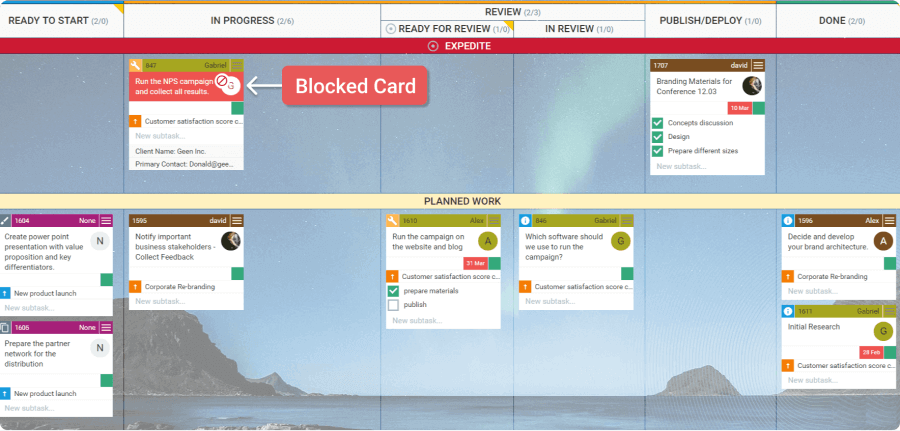
The same idea applies to project or task delays of any sort. For example, it's not uncommon for specific cards to stay longer on the Kanban board than usual. A good practice here is to visually mark the outliers so they can be classified and further examined.
Let us introduce you to some practical tips to manage blocked and delayed work within the Businessmap (formerly Kanbanize) system to put this into perspective.
Making the Most of Visual Blockers & Stickers in Businessmap
The software allows you to create custom blockers for work items and generate reports to analyze the blocked work in your process. Furthermore, with the help of Kanban stickers, you can communicate important information about current tasks in the flow, including reasons why they took longer until completion.
Without further ado, let's see how all of that happens in practice.
Visualizing Blocked Work
Let's imagine that you are working on an Engineering Design project, and an important issue emerges on one of your tasks (Kanban cards). You figure out that the best way to resolve it is to share the problem with your teammates and take time to brainstorm different ideas.
In case all of your colleagues are currently busy and you can't hold a discussion with them right away, the issue represents an impediment to your process. The first thing you would have to do in this situation is add a relevant blocker to your Kanban board.
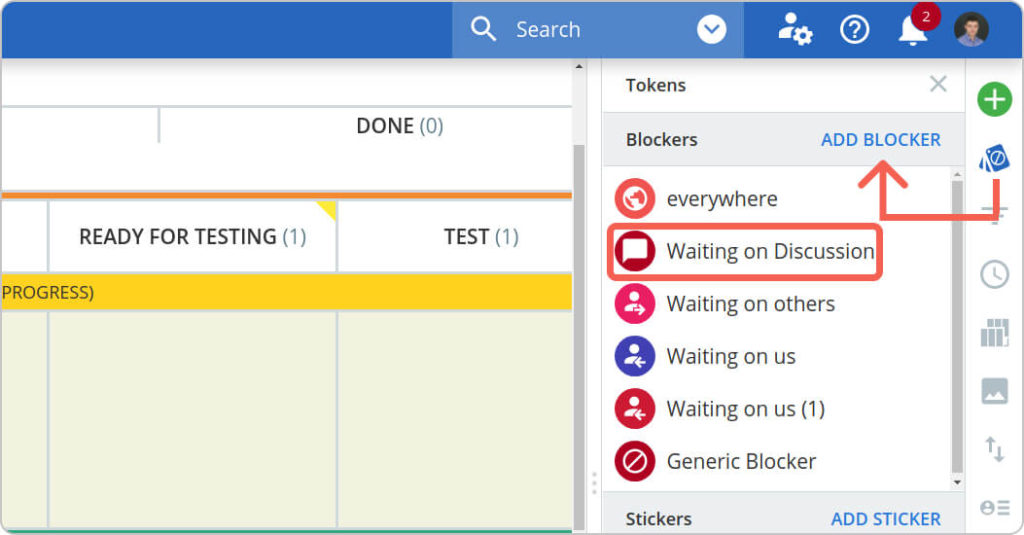
As you can see from the image above, I've added a "Waiting on Discussion" blocker, which describes the reason for the impediment. Next, all you have to do is apply the blocker to the task, deliverable, or even project you are working on and inform your team about it.
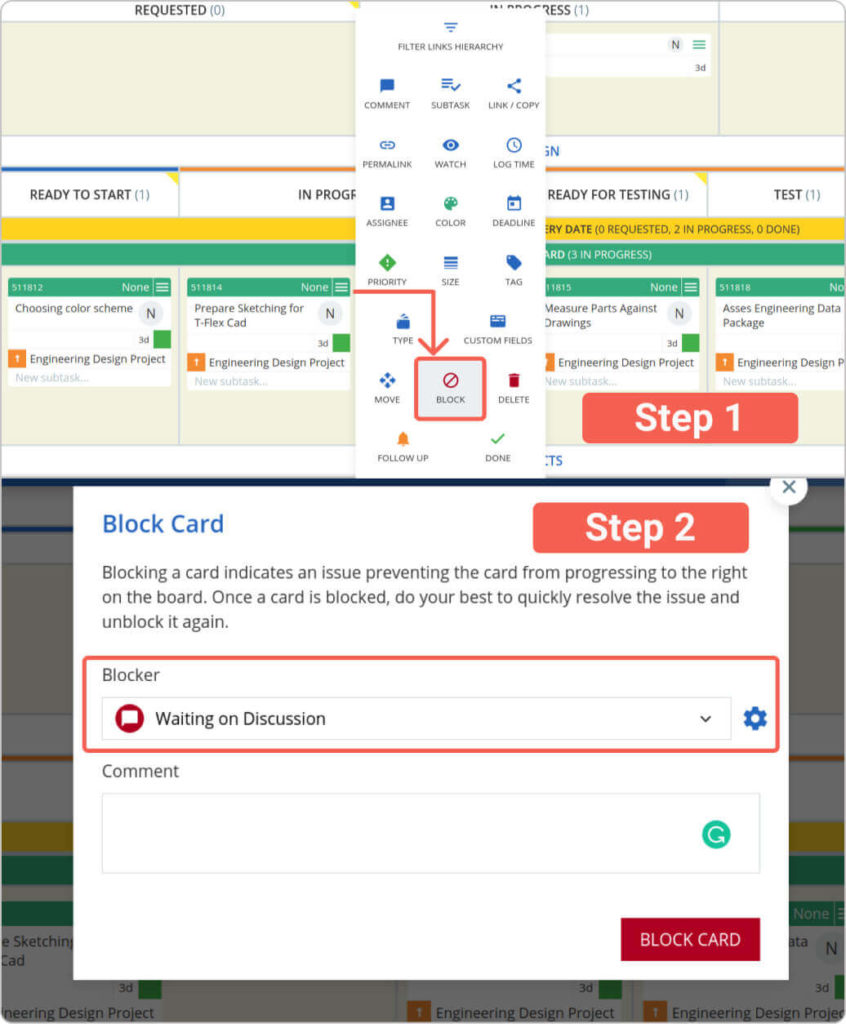
This will provide a quick and clear signal to them about the current state of the work item without having to log the issue in a special register. It will also inform your team members not to start work on any other tasks until the impediment is resolved and the normal flow can resume.
This same idea applies to any other blockers that might appear in your work process.
For example, it's widespread in a knowledge work environment for new dependencies (such as a necessary input from a senior member of another team) to unexpectedly emerge. All you have to do in this situation is to visually mark the work item with a relevant blocker (ex. "Waiting on others") and escalate the issue to the concerned party as soon as possible.
By progressively visualizing blockers in your process, you will eventually generate visual signals for your process's most common impediments. Inside Businessmap you can quickly view all of them as part of the card tokens on your Kanban board.
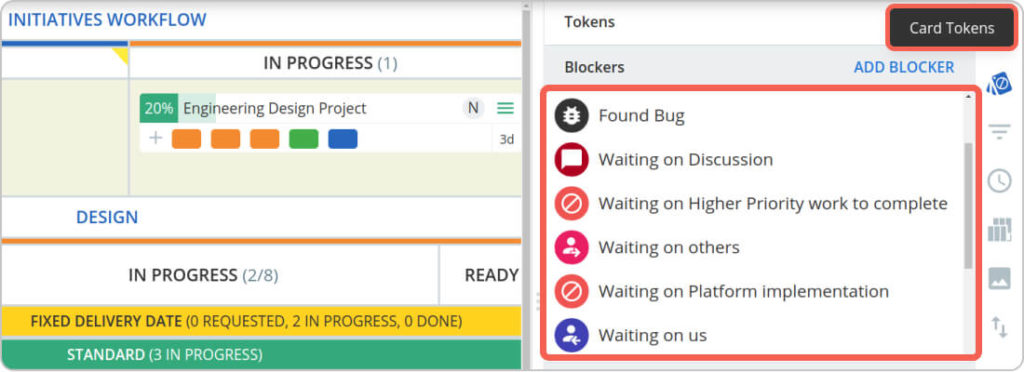
Analyzing Blocked Work
Imagine that recently you've been generating a large amount of blocked work. This has been harming your process and steadily increasing your work item's cycle time.
To deal with this problem, one of the best practices in Kanban is to continuously measure flow metrics and track changes in your team's cycle time. With the help of Businessmap, you can easily accomplish this by accessing the cycle time scatterplot.
There, you can also visualize any work items that were blocked for an extensive amount of time and impeded the flow in your process.
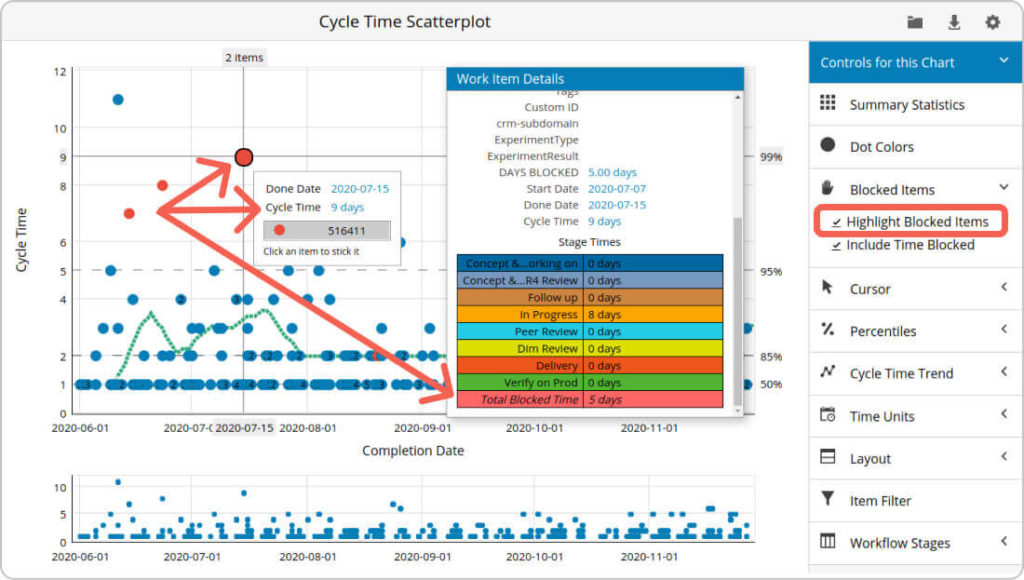
As you can see from the image above, along with all the work items that were finished for a given period, the system also allows you to highlight the blocked tasks. By taking a look at this view of the cycle time scatterplot, you can quickly discover the blockers in your process that caused your cycle time to increase and then look for improvements.
Other than that, one of the best practices in Kanban and Agile is to hold cadences/feedback loops on a regular basis, such as Service Delivery Reviews. During those meetings, you can set a policy for your team to review all work items that were blocked for a given period, discuss the reasons for that, and this way, seek continuous improvement.
For example, let's say that you choose to review all tasks that were blocked for more than one day as those represent the outliers in the process. With Businessmap, you can easily generate such a report by accessing the "Advanced Search" feature.
All you have to do there is refine the search criteria and choose the filters from the image below.
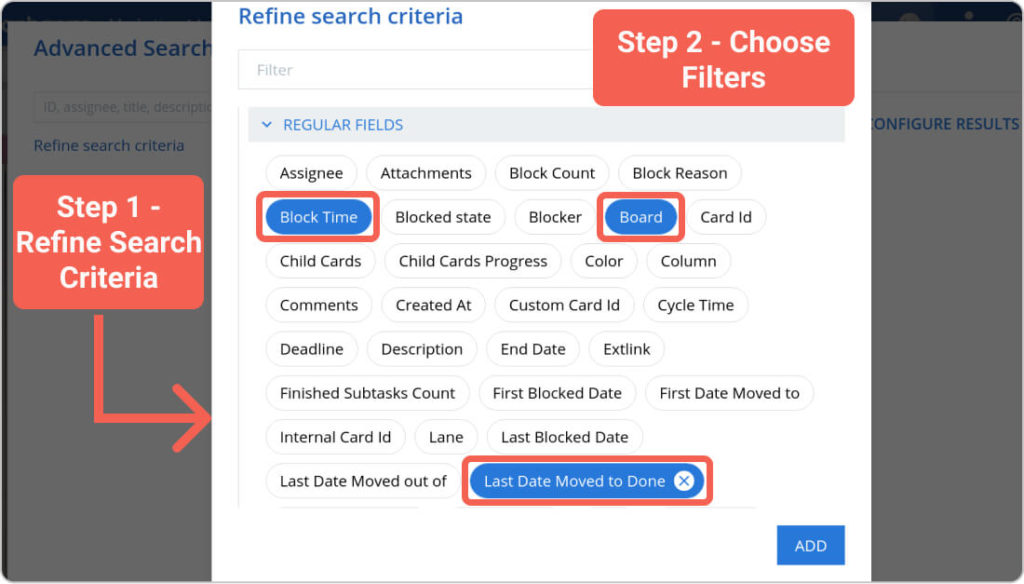
This will generate a report for your team's Kanban board, showing you all the work items that were blocked for a given time frame (hours, days, etc.) during a specific period (weeks, months, etc.). As a result, you will be able to engage in discussions with your team regarding the outliers in your process and analyze the root cause for these lengthy blockers.
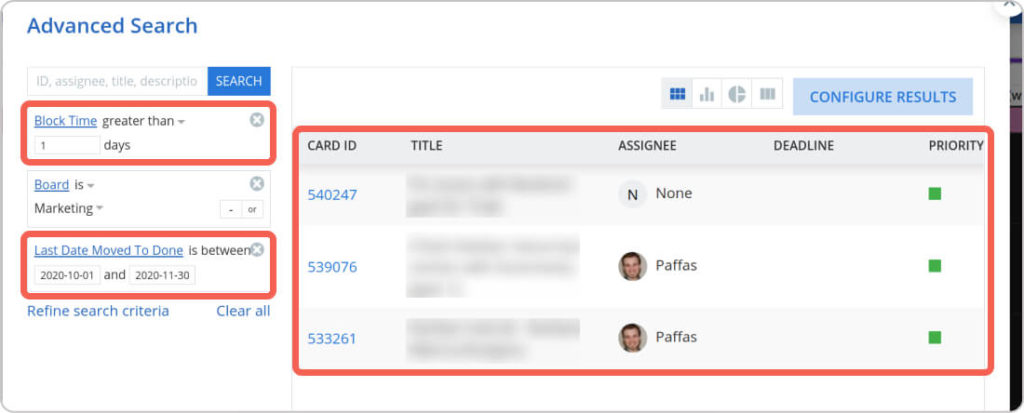
Visualizing Work Delays
Last but not least, it's not uncommon for work items to get delayed due to some other reasons unrelated to impediments to the workflow.
For example, a member of your team might decide that a particular task needs more research before it is successfully completed. This will cause the work item to linger in your workflow longer, which will increase its cycle time.
To avoid confusion about the task's unexpectedly long cycle time, you can visually mark it with a relevant Kanban sticker, as seen from the image below.
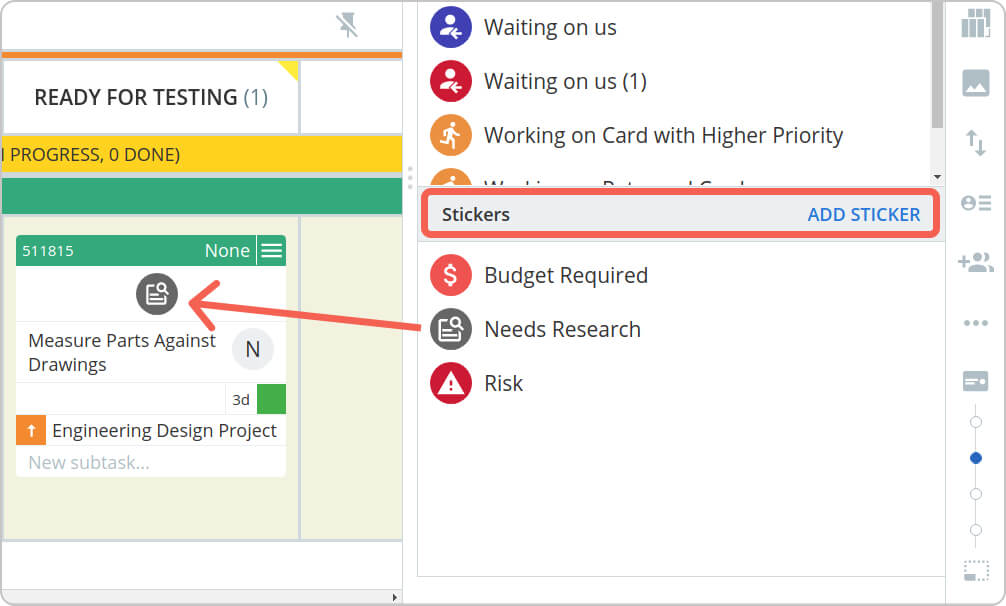
This practice is simple but very effective. By applying the Kanban stickers to the cards in your workflow, you can quickly communicate delay reasons with team members and other relevant stakeholders.
In case the work item turns out to be bigger and more complex than initially expected, good practice in Kanban is to ask one of your colleagues (depending on their capacity) to "swarm around" the task. In other words, collectively work on it.
Eventually, this will lead to a faster and more efficient workflow as well as improved team collaboration.
Use Cases and Benefits of Visualizing Blockers and Delays
Using visual blockers and Kanban stickers to manage delays and impediments provides some clear benefits for maintaining an efficient workflow in a volatile project environment. Let's take a look at some of them, including use case scenarios below.
- Faster Workflow & Market Delivery
Using visual signals to mark impediments (blockers) and delays in your workflow enables teams to communicate issues or escalate them to concerned parties quicker. This creates a system for issue management in real-time, which speeds up the workflow and enables a faster market delivery.
- Input for Root Cause Analysis
Project managers can use visual signals, Kanban blockers, and stickers to classify different problems with work items within their system. By generating reports and tracking flow metrics (as we showed you above), you can continuously analyze the amount of blocked and delayed work in your process.
You can then use this information to run a root cause analysis of your process's problems and engage in discussion with your teams to collectively reach solutions.
- Improved Workflow Predictability
Continuously visualizing and tracking blockers helps you classify the problems in your system and build actionable policies once they occur. By gathering knowledge about workflow issues, you will be able to either fully prevent some of them or at least tailor your processes so you can react faster to others.
This will eventually result in a more predictable delivery process.
At the End of the Day...
As with everything else in Kanban, look to start where you are now and then evolve from there. Try to first figure out the most common impediments/issues you encounter in your process and visualize them on the Kanban board.
Once that's done, keep an eye on your flow, collect data, and generate reports. However, don't forget to regularly communicate the problems with your team and seek collaborative solutions.
At the end of the day, this is what lies in the heart of agility.

Nikolay Tsonev
Product Marketing | PMI Agile | SAFe Agilist certified
Nick is a seasoned product marketer and subject matter expert at Businessmap, specializing in OKRs, strategy execution, and Lean management. Passionate about continuous improvement, he has authored numerous resources on modern-day management. As a certified PMI practitioner and SAFe Agilist, Nick frequently shares his insights at Lean/Agile conferences and management forums.



